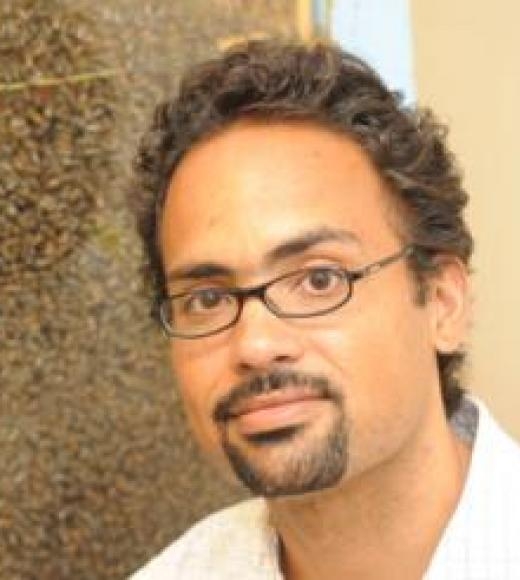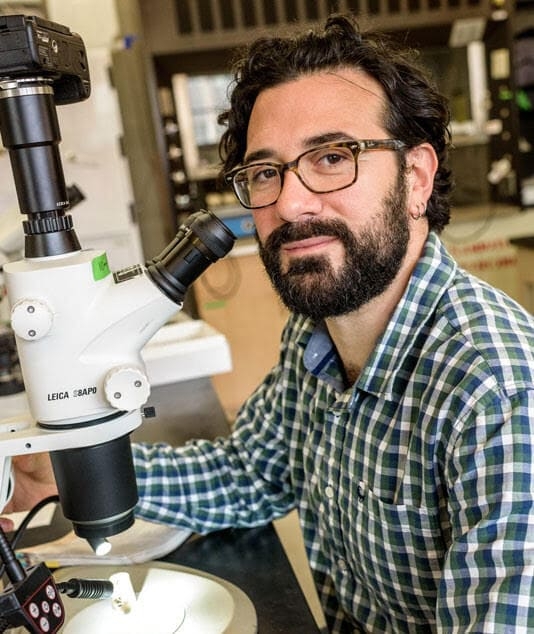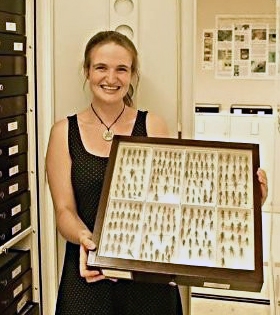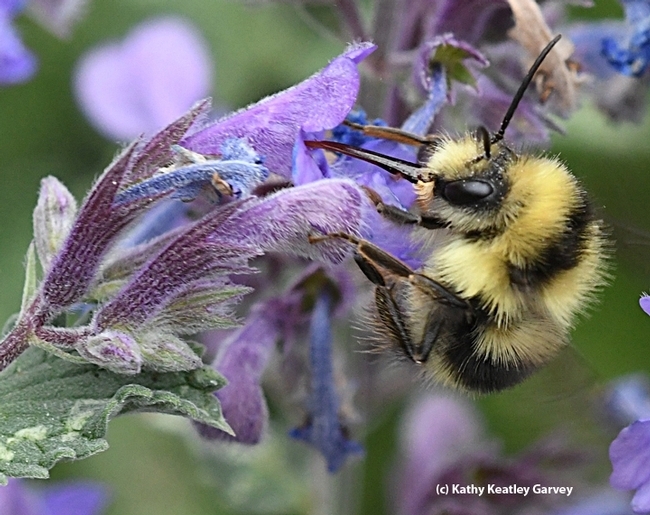
All seminars will be in-person and will take place on Mondays at 4:10 p.m. in Room 122 Briggs Hall through Dec. 4, and also will be broadcast on Zoom. The exception: UC Davis doctoral alumnus' Charlotte Alberts' seminar on Nov. 13 will be Zoom only.
Pollination ecologist Neal Williams, professor, UC Davis Department of Entomology and Nematology, will introduce CaraDonna.
The Zoom link:
https://ucdavis.zoom.us/j/
The schedule:

Paul CaraDonna
Research scientist at the Chicago Botanic Garden and a professor of instruction at Northwestern University
Title: "Understanding the Dynamics of Plant-Animal Interactions in a Changing World"
Abstract: "Plant-pollinator interactions are ubiquitous and play an important role in ecosystem functioning across the globe. Critically, plants, pollinators, and their interactions face numerous threats in our changing world, including those related to climate change. However, our understanding of the consequences of these threats to plant-pollinator interactions has been hampered because we lack knowledge of the basic ecology of many of these organisms, and how their ecology responds to changing abiotic and biotic conditions. We will investigate these issues in this seminar."
Monday, Oct. 9
Geoffrey Attardo
Associate professor and medical entomologist/geneticist, UC Davis Department of Entomology and Nematology
Title: “The Mating Biology of Tsetse Flies – Insights into the Morphological, Biochemical, and Molecular Responses to Mating Stimuli in a Viviparous Disease Vector”
Abstract: "Research into the reproductive behavior of tsetse flies offers key insights into controlling diseases like African sleeping sickness. Unique among insects, these flies give birth to live offspring. During mating, males transfer a mix of sperm and other vital substances to the females. This study employs state-of-the-art techniques, including 3D scanning and genetic analysis, to monitor changes in the female fly's reproductive system over a 72-hour period post-mating. Findings indicate that mating sets off a chain of intricate changes in the female, affecting everything from biochemistry to gene activity. These changes prepare her for pregnancy and childbirth. The study opens up new avenues for understanding tsetse fly biology and offers potential strategies for disease control."

Anthony Domiano Vaudo
Research entomologist, U.S. Forest Service, Rocky Mountain Research Station
Title: "Pollen Nutritional ecology of Bee-Flower Interactions"
Abstract: "Pollen provides bees their primary source of protein and lipid macronutrients, essential for development, fitness, and resistance to stress. Yet, pollen macronutrient quality differs substantially among host-plant species. And thus, bees may be sensitive to their nutritional needs and differentially forage among host plants to obtain appropriate nutrition. In this presentation, I will highlight my research that has linked bumble bee host plant foraging preferences to pollen nutritional quality and individual and colony health. Using this as a theoretical framework, I will present recent research where I show that floral pollen nutritional quality can help explain the structure and patterns of bee-wildflower community interactions among diverse populations; and how this research can inform conservation practices. Finally, I will discuss how the quality of pollen that bees collect may differ between and remain consistent within species populations and help explain their history of floral preferences."
Monday, Oct. 23
Sascha Nicklisch
Assistant professor, UC Davis Department of Environmental Toxicology Department
Title: "Disarming the Defenses of Resistant Pests: Rational Design of Inhibitors for ABC Transporter Proteins in the Varroa Mite"
Abstract: "Varroa mites pose a significant global menace to honeybee colonies, causing colony losses, ecological imbalances, and food scarcity. Escalating pesticide resistance in these mites necessitates innovative strategies to bolster acaricide effectiveness. Small molecule synergists that heighten mite susceptibility to acaricides offer a promising solution by amplifying chemical treatment efficacy, thus reducing overall pesticide demand. Present synergist development strategies primarily target metabolic enzyme inhibition to restore insect sensitivity to pesticides. Our research focuses on ABC efflux transporters, pivotal in cellular xenobiotic handling, as a new approach. We aim to establish a toxicokinetic pipeline to uncover novel synergists and validate their ability to increase Varroa mite vulnerability to existing miticides. By capitalizing on synergistic interactions between sensitizing agents and acaricides, we aim to equip beekeepers and regulators with a sustainable toolbox to combat Varroa resistance, ultimately fostering long-term honey bee well-being."
Monday, Oct. 30
Rodrigo Monjaraz-Ruedas
Department of Biology, San Diego State University
Title: "Ring Species, Ring Speciation or a Ring of Species? An Example with California Mygalomorph Spiders."
Abstract: "Ring species can be defined as a chain of interbreeding populations which expands along two pathways around a geographic barrier, where terminal forms can coexist without interbreeding. A broken ring species model preserves the geographic setting and fundamental features of an idealized model but accommodates varying degrees of gene flow restriction through evolutionary time. Members of the genus Calisoga are distributed around the Central Valley of California, and previous genetic studies have shown that this is a lineage-rich complex of mygalomorph spiders, with evidence to suggest that Calisoga might be a case of ring speciation. Here we examine broken ring species dynamics in Calisoga spiders, using UCEs and mitogenomes we test key predictions of timing, ancestry, connectivity and terminal overlap. I will discuss why ring species should not be viewed as homogeneous entities, but rather as heterogeneous units with different predicted evolutionary dynamics in different geographic parts of the ring."
Monday, Nov. 6
Jason Hong
Research Microbiologist at the USDA-ARS United State Horticultural Lab in Fort Pierce, FL.
Title: "Managing Soilborne Pathogens and Pests with Anaerobic Soil Disinfestation (ASD)"
Abstract: "Growers consider soilborne disease management one of their main production issues. It is estimated that members of the soilborne pest complex (SPC), weeds, nematodes, fungi, oomycetes, bacteria, viruses, and protozoans, account for 10-20% crop loss annually worldwide. Methyl bromide was used to manage the SPC, however, it was discovered that it contributed to ozone depletion, thus was banned worldwide. Currently, no registered alternative chemical fumigant is as effective as methyl bromide for SPC management. Anaerobic soil disinfestation (ASD) is biologically based alternative to soil fumigation. ASD consists of amending the soil with a labile carbon source, tarping the soil with a plastic film, and watering the soil under the film to field capacity. During the ASD process the soil microbiome undergoes populations shifts and various anti-microbial compounds are produced. ASD has shown to be as effective as methyl bromide SPC management. This presentation will discuss the history of ASD and current research."

Charlotte Alberts
Smithsonian National Museum of Natural History
Title: "Assassin Fly (Diptera: Asilidae) Systematics and Predator Ecology"
Abstract: "Assassin flies (Diptera: Asilidae) are a diverse family that plays an essential ecological role as top aerial and venomous predators. Little is known about the evolution of their predatory habits. This study provides a novel phylogenetic hypothesis of Asilidae along with prey preference and ancestral state reconstruction in a maximum likelihood framework. This study is based on 176 assassin fly species, 35 Asiloidea outgroup species, 3,400 prey preference records accumulated from literature and museum collections, and approximately 7,913 bp of nuclear DNA from five genes (18S and 28S rDNA, AATS, CAD, and EF-1a protein-encoding DNA) and mitochondrial DNA from one gene (COI). Of the 12 asilid subfamilies included in the analysis the monophyly of six was supported. We used ancestral state reconstruction and stochastic character mapping to test whether a polyphagous arthropod predator is the ancestral state for Asilidae. Assassin flies are polyphagous arthropod predators, with specialized arthropod prey preferences evolving 20 independently across the Asilidae phylogeny. I will also summarize my other dissertation chapter, a review of Nearctic Saropogon with a new species description."
Monday, Nov. 20
Etienne GJ Danchin
Evolutionary biologist working with genomes: INRAE (French National Research Institute for Agriculture, Food and Environment) senior scientist and scientific leader of the GAME team (Genomics and Adaptive Molecular Evolution) at ISA (Institut Sophia Agrobiotech), in Sophia-Antipolis, on the French Riviera.
Title: "Parasitic Success in the Absence of Sex: What Have We Learned from Nematode Genomes?"
Abstract: "Root-knot nematodes are devastating plant parasites of worldwide importance. Interestingly, species that cause most damages reproduce entirely asexually. These nematodes are extremely polyphagous and have a wide geographic range. Theoretically, in the absence of sexual recombination animal species have lower adaptive potential and are predicted to undergo genome decay. To investigate how these species can be successful parasites on many hosts and in many places around the world, we have sequenced and analyzed their genomes. Out analysis confirmed these species are polyploid hybrids and the combination of several genotypes from different species might provide them with a general-purpose genotype. However, this does not explain how with a theoretically fixed genotype these species are able to overcome resistance genes or adapt to a new host. Therefore, we analyzed genomic variability across different populations and the possible mechanisms underlying genomic variations. In this presentation, I will provide an overview of our findings."
Monday, Nov. 27
Arnon Dag
Senior Scientist in the Institute of Plant Sciences, The Volcani Center, Israel
Title: "Improving Cross-Pollination in Deciduous Fruit Trees"
Abstract: "Tree crops belonging to the Rosaceae, such as almond, pear, apple, and sweet cherry, depend on cross-pollination by insects to set fruit. The primary pollinator of the crops is the honey bee (Apis mellifera). However, due to harsh climatic conditions during flowering, limited movement of bees between cultivars, low preference of the bees for flowers of the target crop, and limited overlap in flowering between the cultivars, pollination is a primary factor limiting yield. Our group has tested multiple approaches to mitigate this problem: Using 'Pollen dispensers,' sequential introduction of beehives to the orchards, selection of honeybee strains with higher preference for the target crop, introduction of bumblebee (Bombus terrestris) colonies and phosphorous fertilization to increase nectar secretion and improve crop-flower attractiveness. I will summarize the effects of those methods on fruit set and yield in apples, almonds, and pears."

James Nieh
Professor in the Section of Ecology, Behavior, and Evolution, Division of Biological Sciences, University of California, San Diego, and associate dean in the Division of Biological Sciences
Title: "Danger, Dopamine, and Dance: New Insights from the Magic Well of Honey Bee Communication"
Abstract: "Karl von Frisch referred to the waggle dance as the 'magic well' for the insights that it provides not only on honey bees, but on the general cognitive complexity that social insects are capable of. New research demonstrates that the neurotransmitter, dopamine, the “pleasure molecule” plays a similar hedonic role in honey bees as it does in many vertebrates, regulating the perception of danger and the anticipation of food rewards as revealed in the excitatory waggle dance and the associated, inhibitory stop signal. I will also discuss new data showing that the honey bee waggle dance is partially learned and has elements that may be culturally transmitted. Together, these findings, demonstrate that the waggle dance can teach us a great deal about shared cognitive mechanisms and the importance of social learning across taxa."
For seminars technical issues, contact Johnson at brnjohnson@ucdavis.edu.
Johnson, a leading expert on the behavior, genomics and evolution of honey bees, is the author of a newly published book, “Honey Bee Biology,” released June 6 by Princeton University Press. Johnson joined the UC Davis faculty in 2011 after conducting postdoctoral research at UC San Diego and UC Berkeley. He focuses his research on the behavior, evolution, theoretical biology and genomics of the honey bee.
“Our lab studies the genetics, behavior, and evolution of honey bees,” Johnson writes on his website. “We use experimental and theoretical approaches to all the questions we explore. Current work in our lab focuses on the evolution and genetic basis of social behavior using comparative and functional genomics, task allocation using behavioral and theoretical approaches, and honey bee health using a combination of genetics, epidemiology, and physiological approaches.”
Attached Images:
